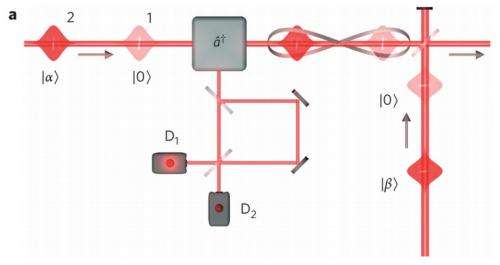July 15, 2014 feature
Entanglement between particle and wave-like states of light resembles Schrodinger's cat experiment (Update)

(Phys.org) —While entangling cats with atoms is not exactly an active area of research in any physics lab today (as far as anyone knows), many physicists are working on a close analogy of Schrödinger's cat experiment. That is, they are developing methods to entangle classical objects (analogous to the cat) with quantum particles (like an individual atom).
In a new paper published as the July 2014 cover article in Nature Photonics, physicists Hyunseok Jeong, et al., at institutions in South Korea, Italy, and Australia, have devised and experimentally demonstrated a novel scheme to generate entanglement between quantum and classical (or "particle-like" and "wave-like") states of light. This study marks the first time that physicists have generated entanglement between a single photon and a coherent wave-like state of light.
According to the scientists, this hybrid entanglement can be considered as the closest analogy of Schrödinger's Gedankenexperiment realized so far. It has practical applications, too, as it provides a new type of qubit (a hybrid qubit) that can be used for efficient quantum computation.
In previous attempts to generate entanglement between a single photon and coherent wave-like state of light, the major obstacle was the requirement of a strong and noiseless nonlinear interaction between photons; this was extremely difficult because photons seldom interact with each other.
In the new study, the researchers introduced a new scheme to generate hybrid entanglement that is experimentally accessible. The new scheme is based on superposition. Similar to how Schrödinger's cat is both alive and dead at the same time before anyone looks, the photons also occupy two states at the same time.
Rather than being dead and alive, however, the states correspond to the long and short arms of the interferometer through which each photon travels. It's as if a photon traveled through both arms at the same time. By performing a procedure that erases the information regarding which arm the photons travelled through, the physicists could entangle a photon with a wave-like state that they call a photon-added coherent state.
Because the new state is essentially a superposition including both particle and wave components, it can be viewed as a new type of qubit. Usually, a qubit consists of a particle that is in a superposition of two quantum states. The new idea here is that a qubit can consist of a quantum (or particle-like) state and a classical (or wave-like) one, which could effectively combine the intrinsic advantages of both. In this way, a hybrid qubit could offer unique advantages for quantum computing and quantum teleportation.
"Using hybrid qubits, it is possible to implement quantum information processing (such as quantum teleportation and quantum computing operations) with both high success probability and high fidelity," Hyunseok Jeong at Seoul National University told Phys.org. "It was difficult to achieve this goal merely with particle-like qubits or with wave-like qubits. With particle-like qubits, the fidelity of quantum information processing can be made high but the success probability becomes low, and it is exactly the opposite with the wave-like qubits. Using the hybrid qubits, one can combine the advantages of both approaches so that quantum information processing can be efficiently performed."
In the future, the researchers plan to increase the size of the classical objects used in the entangled state, which will make them more practical for applications.
"At the moment, we have performed a proof-of-principle demonstration," said coauthor Marco Bellini at the Istituto Nazionale di Ottica (INO-CNR) and the University of Firenze, both in Florence, Italy. "In our experiment, the classical part of the entangled state (the analogue of the 'alive' and 'dead' superposition state of the Schrödinger's cat) is the superposition between two weak laser pulses with opposite phases. Since they contain just a few photons on average, they are very small classical objects indeed (very different from a macroscopic cat), so our next plans are to find ways of generating hybrid entangled states where the classical component can be made larger. Besides the fundamental interest related to the paradoxes of quantum mechanics, this will also make them more useful for applications in quantum information processing."
In the same issue of Nature Photonics, a second paper by Olivier Morin, et al., was also published on a new method to create hybrid entanglement between particle-like and wave-like optical qubits. The work was performed independently from the first paper, and was led by Professor Julien Laurat at the Laboratoire Kastler Brossel in Paris.
Here, the researchers demonstrated similar hybrid entanglement, but performed state preparation remotely. They showed that a distance of more than 80 km is possible between the particle-like (quantum) part and the wave-like (cat) part of the generated state. This ability opens a path to realizing heterogeneous long-distance quantum networks.
Using this method, the researchers generated a hybrid state whose "cat part" is 10 times larger than that generated in the method used in the other paper. The work marks an important step toward the realization of wave-like states of increasingly larger size.
More information: Hyunseok Jeong, et al. "Generation of hybrid entanglement of light." Nature Photonics. DOI: 10.1038/nphoton.2014.136
Olivier, Morin, et al. "Remote creation of hybrid entanglement between particle-like and wave-like optical qubits." Nature Photonics. DOI: 10.1038/nphoton.2014.137
Journal information: Nature Photonics
© 2014 Phys.org


















